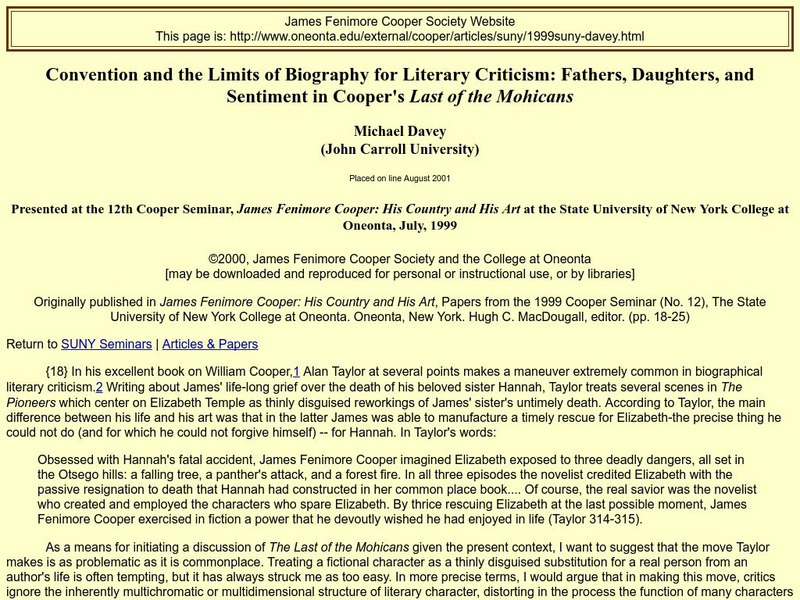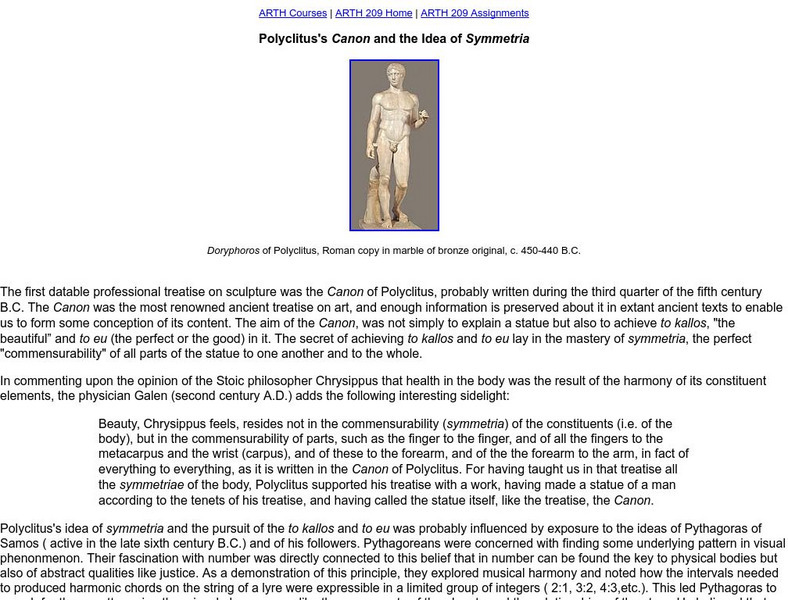State University of New York
Going Back in Time Using “George Washington’s Socks”
After reading Elvira Woodruff's George Washington's Socks, young readers and writers embark upon writing their own historically based story, with a focus on developing ideas and details throughout the piece. In small groups, class...
State University of New York
Convention & the Limits of Biography for Lit Crit
This web-article is about James Fenimore Cooper and some of the biographical criticism that has been done of his work. Takes to task the shortcomings of this particular critical approach.
State University of New York
The James Fenimore Cooper Society
This website has everything you need to know about James Fenimore Cooper and is a good starting point for anyone doing research on this 19th-century author. Included are a detailed biography of him, literary comments about his writings,...
State University of New York
Oneonta: Reading "The Pioneers" as History
This detailed site provides a guide for reading "The Pioneers" by James Fenimore Cooper. Includes background information about the book, a description of the setting and form, a list and description of principal characters, and...
State University of New York
College at Oneonta: Polyclitus Canon, Idea of Symmetria
This site provides a very detailed summary of the Canon of Polyclitus, a written work concerning sculpture and art.
State University of New York
Pence: Careers for Chemistry Graduates
Explore career opportunities for chemistry graduates. Find out the types of schools to investigate and career specific information.
State University of New York
State University of New York: Compounds, Molecules, and the Mole
This simulation explores the relationship between mass, moles, molecules and atoms. Select one of the 6 compounds, set the mass of the compound, and release the scrollbar to calculate.
State University of New York
State University of New York: Limiting Reactants
This simulation explores the "limiting reactant" effect. The extent to which reactants that involve more than one reactant can produce products depends on the quantities of those reactants combined. In most cases, one reactant will be...
State University of New York
State University of New York: Acid Ionization
This simulation is an interactive of acid ionization.
State University of New York
State University of New York: Calorimetry Measuring Heats of Reaction
This simulation uses a "bomb calorimeter," which is designed to measure heat produced during a combustion reaction, where a compound is burned using excess oxygen.
State University of New York
State University of New York: Heat Transfer Between Substances
The following simulation assesses students understanding of thermal energy, transfer and equilibrium.
State University of New York
State University of New York: Hess's Law
Because reactions can be considered "additive," a series of reactions can be written like simultaneous mathematical equations and a net reaction determined by addition. To use this simulation, select individual reactions from the three...
State University of New York
State University of New York: Atomic Absorption and Emission
This module simulates the excitation of hydrogen atoms through irradiation with electromagnetic radiation of different wavelengths.
State University of New York
State University of New York: Atomic Electron Configuration
This simulation displays the electron configurations of for the elements in relation to the element's position on the periodic table.
State University of New York
State University of New York: Electron Configuration of Ions
The following simulation displays electron configurations for elements in relation in relation to the element's position on the periodic table.
State University of New York
State University of New York: Atomic Orbital Energies
This simulation explores the trends observed in orbital energies for the main group elements of atomic orbital energies.
State University of New York
State University of New York: Effective Nuclear Charge, Z*
The following simulation provides an explanation of effective nulcear charge, Z*.
State University of New York
State University of New York: Electron Configurations
The following simulation provides an interaction with electron configurations.
State University of New York
State University of New York: Determining Molecular Shapes
In this exercise students will select the electron-pair geometry for a molecule and drag it onto the central atom. Then they will place the terminal atoms in the appropriate positions on the molecule. Finally students will enter the...
State University of New York
State University of New York: Determining Molecular Shapes
In the following activity, students are required to select a central atom, drag an electron-pair geometry and other appropriate atoms in order to create the molecular structure.
State University of New York
State University of New York: Drawing Lewis Structures
This simulation is an interaction with drawing Lewis structures.
State University of New York
State University of New York: Drawing Lewis Structures
The following simulation contains partially completed Lewis structures and students are required to complete them by dragging bonds and lone electron pairs to their appropriate positions.
State University of New York
State University of New York: Metallic Bonding: Band Theory
This simulation shows a simple band diagram for metals for Group 1A and 2A and the transition series. Each metal's valence orbitals combine to create a band that is responsible for the element's properties.
State University of New York
State University of New York: Mo Diagrams of Homonuclear Diatomic Species
The following module allows students to practice diagrams of of homonuclear diatomic species.

























